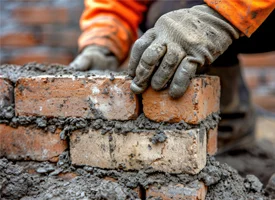During the construction of a building load bearing structure is commonly used. When the building walls and ceiling are freshly placed, engineers use this mentored to support the ceiling. Let us understand what is load bearing structure in detail.
Design your house with durable material by consulting designers here.
How can we define load bearing structure?A load bearing structure carries the weight of the component of the building and
transfers this load to the foundation; this is known as load bearing structure. This structure guarantees the strength and stability of the building. The load bearing structure is commonly used for the construction of residential houses upto two or more floors.
Components of load bearing structure
- Load Bearing Wall structure
: A load bearing wall structure holds the load of slabs above the foundation of the construction property.
- Beams:
Beams are the most essential thing required for the load bearing of type support the surface of the building. These beams are made up of wood and metal.
- Columns: Another effective
and most important tool to build the strong foundation of the building
- Brace:
Braces are structural elements used in the framework structural system.
This type of foundation support is less expensive as compared to other machine base support such as farmed structures.
If a builder constructing a building up to three floors then using load bearing structure can be a great idea.
This is all about
what is load bearing structure.
 What is a floor plan?
What is a floor plan?
✕

Fill the Form to get Free Estimate!
End to End Renovation Solutions for your Home
 High Quality Material
High Quality Material
 In House Team of Experts
In House Team of Experts
 On Time Completion
On Time Completion
 Dedicated Engineer & Project Team
Dedicated Engineer & Project Team
 Warrant
Warrant
 Cost Transparency
Cost Transparency

Living Room Renovation
GET FREE QUOTE

Bathroom Renovation
GET FREE QUOTE

Full Home Renovation
GET FREE QUOTE

Kitchen Renovation
GET FREE QUOTE

Tiling Work
GET FREE QUOTE

Fabrication Work
GET FREE QUOTE

Mason Work
GET FREE QUOTE

Extension
GET FREE QUOTE

Seepage Work
GET FREE QUOTE
As a builder, I can tell you what exactly the load bearing house means. In simple terms, I can say that load-bearing walls are essential parts of concrete construction. They support an entire building and transfer weight to the foundation underneath it, which maintains its rigidity and stability. The structural integrity of a concrete building depends on a number of important components that homeowners and renovators should be aware of. Let’s learn more about load bearing foundation below.
Components of load bearing structural system
The entire weight of the building and its belongings are distributed securely to the ground via load-bearing structures. As Vidha Shukla mentioned above, the principal structural components that carry load are:
Walls: Load bearing walls carry loads from the slabs above them to the base. Concrete, masonry, or block materials may be used to construct these walls.
Beam: One of the main load-bearing elements of a construction is the beam, which can be made of metal, concrete, or wood.
Columns: A structure's columns are essential because they efficiently transfer the dead and live loads that the building structure is subjected to to the base.
Braces: This component aids in successfully stiffening the framework.
Trusses: These are load-bearing sections that hold the roof while transmitting uniform roof loads and subjecting them to tension and compression stresses.
The procedure used in the case of a load-bearing structural system is
Slabs >> Walls >> Foundation Get elegant house without brokerage via NoBroker Buyer Plans Make your house more glamorous with NoBroker Home Interior Service Read more -What is a Floor Plan?
What is the Difference Between Load Bearing Structure and Framed Structure?
What are the Advantages of Combined Footing with Reinforcement?
✕

Fill the Form to get Free Estimate!
End to End Renovation Solutions for your Home
 High Quality Material
High Quality Material
 In House Team of Experts
In House Team of Experts
 On Time Completion
On Time Completion
 Dedicated Engineer & Project Team
Dedicated Engineer & Project Team
 Warrant
Warrant
 Cost Transparency
Cost Transparency

Living Room Renovation
GET FREE QUOTE

Bathroom Renovation
GET FREE QUOTE

Full Home Renovation
GET FREE QUOTE

Kitchen Renovation
GET FREE QUOTE

Tiling Work
GET FREE QUOTE

Fabrication Work
GET FREE QUOTE

Mason Work
GET FREE QUOTE

Extension
GET FREE QUOTE

Seepage Work
GET FREE QUOTE
Before constructing a house you should be aware of what components are important for a structure and the relevance of the load bearing structure section. A load-bearing structure refers to the part of a building or structure that carries and transfers the weight and loads to the foundation or supporting elements. It is designed to provide stability, strength, and support to the overall structure. The load-bearing structure section typically includes various components that work together to distribute and bear the loads efficiently. Here are some key elements typically found in a load-bearing structure. So this is the load bearing wall definition in brief.
What are the advantages of a load bearing structure?
Some of the advantages of a load-bearing structure are-
Load-bearing structures offer cost-effectiveness by reducing the need for extensive structural elements.
They provide efficient use of materials as the walls themselves act as load-bearing elements.
Load-bearing structures allow for flexible and adaptable interior spaces without the need for additional support.
They offer simplicity in construction, making them easier and faster to build.
Load-bearing structures provide excellent thermal insulation due to the mass of the walls.
They offer good sound insulation, reducing noise transmission between rooms.
Load-bearing structures have high durability and can withstand a variety of environmental conditions.
They provide inherent fire resistance due to the use of materials like brick or concrete.
Load-bearing structures can have aesthetic appeal as the walls can be exposed and showcase the building's materials.
They allow for easier integration of architectural features, such as arches or niches, into the structure itself.
So this is what does load bearing wall mean and some of its advantages I am aware of. Such components are vital for a structure to make it durable and most importantly safe. I will always suggest you discuss with the engineer about the load bearing structure section before starting your construction.
Buy or rent durable and legally verified properties through NoBrokerRead More:
What is a load bearing wall? Difference between load bearing structure and framed structure Stepwise construction procedure of load bearing structure✕

Fill the Form to get Free Estimate!
End to End Renovation Solutions for your Home
 High Quality Material
High Quality Material
 In House Team of Experts
In House Team of Experts
 On Time Completion
On Time Completion
 Dedicated Engineer & Project Team
Dedicated Engineer & Project Team
 Warrant
Warrant
 Cost Transparency
Cost Transparency

Living Room Renovation
GET FREE QUOTE

Bathroom Renovation
GET FREE QUOTE

Full Home Renovation
GET FREE QUOTE

Kitchen Renovation
GET FREE QUOTE

Tiling Work
GET FREE QUOTE

Fabrication Work
GET FREE QUOTE

Mason Work
GET FREE QUOTE

Extension
GET FREE QUOTE

Seepage Work
GET FREE QUOTE
The load-bearing construction or building ensures the effectiveness and immovability of the building. In reality, it is a structural system in which walls transfer loads from structures, such as the weight of the building itself and the weight of people living there, to the underlying foundation. So let me explain in detail what is load bearing wall meaning.
Want better advice on house design? Get on a call with designers now.What is load bearing construction?
Load-bearing structures are those whose walls, in addition to supporting the structure's own weight, hold the weight of the entire object. Load-bearing walls in a structure are the interior and exterior walls that support trusses and other systems. This is what load bearing structure means.
What are the benefits of load bearing structure?
The load-bearing building or structure relates to the construction's effectiveness and stability. It is actually the structural system where loads of structures, such as the weight of the building itself and the living loads, are transmitted from side-to-side walls to the underground foundation.
The most beneficial use of load-bearing is obvious in this structural system, which also serves a variety of functions, such as supporting loads, freeing up space, protecting the structure from heat and sound, etc.
What are the drawbacks of load bearing structure?
The ideal match for this load-bearing building is one with up to three floors.
Load-bearing masonry structures require more labour and take longer to build than structures built using other construction techniques.
Masonry buildings don't provide enough weatherproof thermal isolation.
Once the building has begun, the position of the walls cannot be changed.
You are now well aware of load bearing wall meaning.
Purchase efficient furniture via NoBroker at very affordable rates here. Read More: Stepwise construction process of load bearing structure? What is framed structure building? What is RCC framed structure?✕

Fill the Form to get Free Estimate!
End to End Renovation Solutions for your Home
 High Quality Material
High Quality Material
 In House Team of Experts
In House Team of Experts
 On Time Completion
On Time Completion
 Dedicated Engineer & Project Team
Dedicated Engineer & Project Team
 Warrant
Warrant
 Cost Transparency
Cost Transparency

Living Room Renovation
GET FREE QUOTE

Bathroom Renovation
GET FREE QUOTE

Full Home Renovation
GET FREE QUOTE

Kitchen Renovation
GET FREE QUOTE

Tiling Work
GET FREE QUOTE

Fabrication Work
GET FREE QUOTE

Mason Work
GET FREE QUOTE

Extension
GET FREE QUOTE

Seepage Work
GET FREE QUOTE
I am a civil engineer and I often hear the term load bearing structure foundation used wrongly by laymen or people who are not very well aware of the term. So, I will take this opportunity to answer your query and also tell you about load bearing structure foundation in a very easily understandable language. A load-bearing structure is one that bears the weight of the floor or roof structure above it. They are given this name because they carry the burden and support the structure's weight. A load-bearing wall transfers its weight to a structure underneath called the foundation. An architect, structural engineer, or other professionals should be consulted if you are thinking about remodelling to determine if a structure is a load-bearing or not.
Wish to remodel your house? Consult the interior designers of NoBroker and get your home remodelled according to your budget.Load bearing meaning and function?
Your house is a sizable one. It houses all of your possessions and is constructed from wood and steel, along with some blocks, bricks, and other elements for good measure. Architecture must understand how weight is distributed because a structure must support a lot of weight. The weight is forced downward and outward starting at the top.
The weight that descends a structure is known as the load. As a result, this weight is safely transferred from the roof to the substructure via a load-bearing wall. All of the walls need not be load-bearing because only a handful are needed for this task.
Types of load bearing structure
There are various kinds of load-bearing structures in contemporary architecture. You ought to be familiar with the principal load-bearing structures:
The following is a list of the three main categories of load-bearing structures:
- Concrete Precast Wall:
This form of structure is precast, as the name suggests, which means it is constructed in a controlled setting, allowed to cure, and then moved to the construction area. This kind of wall is less complicated to build, stronger, more important, and easier to maintain.
- Retaining Wall:
A retaining structure often referred to as a bosom or revetment wall, would be a load-bearing structure that supports soil while also assisting in preventing erosion. The holding wall is made to endure lateral load pressure or keep back soil materials, unlike most other barriers.
- Masonry Fencing:
It offers the most design versatility among load-bearing structures. It can be customized to any required height or length since it is not precast. It is robust and long-lasting, doesn't depend much on lateral pressure, resists fire, and works well to regulate indoor temperature.
I believe now even laymen will be able to easily comprehend what is load bearing structure foundation.
Read More: What is a Load Bearing Wall? Difference Between Load Bearing Structure and Framed Structure? Construction Procedure of Load Bearing Structure?✕

Fill the Form to get Free Estimate!
End to End Renovation Solutions for your Home
 High Quality Material
High Quality Material
 In House Team of Experts
In House Team of Experts
 On Time Completion
On Time Completion
 Dedicated Engineer & Project Team
Dedicated Engineer & Project Team
 Warrant
Warrant
 Cost Transparency
Cost Transparency

Living Room Renovation
GET FREE QUOTE

Bathroom Renovation
GET FREE QUOTE

Full Home Renovation
GET FREE QUOTE

Kitchen Renovation
GET FREE QUOTE

Tiling Work
GET FREE QUOTE

Fabrication Work
GET FREE QUOTE

Mason Work
GET FREE QUOTE

Extension
GET FREE QUOTE

Seepage Work
GET FREE QUOTE
Hey,
I read your question online and got curious about the meaning of the term ‘ Load Bearing Structure’. This led me to ask my older sister who is an engineer ‘what does it mean’. Keep reading to know what was revealed.
There are different methods for constructing a building. One of these methods is known as bearing construction. Here, bricks and stones are stacked on top of each other. This allows every brick and stone to equally share the load from the bricks stacked above. This method is also known as the structural wall.
Load bearing structure :Load bearing structure meaning is a structure or a wall wherein the weight of the house is dispersed from top to bottom. These are also known as the load-bearing wall. If this structure is missing in a house, the house will not be as strong and collapse.
Each layer in the wall helps in dispersing the weight from the roof to the foundation of the building. The main feature of any Load bearing structure is that each wall itself acts as a separate load-carrying element.
To further strengthen masonry units, elements like mortar, and cement are added to the middle. Usually houses constructed using this method also use gray cast iron.
Other materials used :
In the process of creating a structure, other materials are used. eg ductile iron, steel, stainless steel, and other kinds of thermoplastics and polyethylene-based plastics.
According to the load bearing structure definition, you must have understood that the load gets transferred from the slab to the foundations through walls.
Advantage :
This structure usually has a brick foundation, beams & columns. A major advantage of this system is thicker walls providing the house with weather resistance and noise protection.
Disadvantage :A major disadvantage of this method is the need for thick walls. This leads to the carpet area decreasing. This structure is not preferred for the construction of multi- storey building. Using this method on a building of more than two floors is uneconomical.
This is all from my end on load bearing structure definition.
Need help choosing perfect property for you ? Check out Nobroker Buyer Plan for a dedicated property expert
and more.
Get expert help on
end to end legal processes including the scrutiny of technical documents only with NoBroker Legal Services.
Read more :
What is the residential house construction cost in Bangalore?
Which brick is best for construction ?
How to make illegal construction legal?
✕

Fill the Form to get Free Estimate!
End to End Renovation Solutions for your Home
 High Quality Material
High Quality Material
 In House Team of Experts
In House Team of Experts
 On Time Completion
On Time Completion
 Dedicated Engineer & Project Team
Dedicated Engineer & Project Team
 Warrant
Warrant
 Cost Transparency
Cost Transparency

Living Room Renovation
GET FREE QUOTE

Bathroom Renovation
GET FREE QUOTE

Full Home Renovation
GET FREE QUOTE

Kitchen Renovation
GET FREE QUOTE

Tiling Work
GET FREE QUOTE

Fabrication Work
GET FREE QUOTE

Mason Work
GET FREE QUOTE

Extension
GET FREE QUOTE

Seepage Work
GET FREE QUOTE
A load-bearing structure is a structure in which loads are transferred to the foundation through walls. This type of structure doesn’t have beams and columns. The load-bearing walls are constructed over a continuous foundation and they’re designed to carry the complete load, including their load. Now you know about the load bearing construction.
People used to opt for this type of structure for the construction of low-rise buildings and small houses in earlier days. But today, they’re rarely adopted. These structures are ideal for the construction of commercial and residential buildings up to 2 floors only.
This type of structure features building components that safely carry and transfer loads to the ground, guaranteeing excellent performance and stability of the building.
Load Bearing Structure DetailsA load-bearing structure is designed to safely take and transmit the load to the subsoil foundation and is a component of a building. Walls resist the self-weight of building or structure, the load of floor and roofs.
In this type of structure, the most constructive use of load-bearing is visible, and it performs a variety of functions, such as subdividing the space, supporting loads, offering acoustic and thermal insulation to the structure, etc.
In this type of structure, you can’t punch holes in a wall to connect 2 rooms as this can damage the structure.
The immense weight of the walls holds the building together and stabilise it against external forces like earthquake and wind.
Now that you have a good understanding of the load bearing construction, let me also explain the difference between the load-bearing and framed structure.
The major difference between framed structure and load-bearing structure is members which carry the structural load and transfer it to the subsoil. In a framed structure, the load is carried by members such as columns and beams whereas, in a load-bearing structure, the load is carried by members such as walls.
Read more:
How to hide a pillar in living room?
How to hide beam in ceiling?
What is the stepwise construction procedure of load bearing structure?
I hope I cleared all your doubts regarding the load bearing construction.
✕

Fill the Form to get Free Estimate!
End to End Renovation Solutions for your Home
 High Quality Material
High Quality Material
 In House Team of Experts
In House Team of Experts
 On Time Completion
On Time Completion
 Dedicated Engineer & Project Team
Dedicated Engineer & Project Team
 Warrant
Warrant
 Cost Transparency
Cost Transparency

Living Room Renovation
GET FREE QUOTE

Bathroom Renovation
GET FREE QUOTE

Full Home Renovation
GET FREE QUOTE

Kitchen Renovation
GET FREE QUOTE

Tiling Work
GET FREE QUOTE

Fabrication Work
GET FREE QUOTE

Mason Work
GET FREE QUOTE

Extension
GET FREE QUOTE

Seepage Work
GET FREE QUOTE
A load bearing structure is a building structure where the load is moved vertically downwards through the walls of the structure. The weight is transferred from the roof to the walls which transfer to the foundation. The load bearing building structure is preferred for constructions of up to 2 floors only.
Make your house design stylish and durable by opting for NoBroker home interior services.
Components of a load bearing structureThe major components of load bearing structure are beam, columns, walls, braces, and trusses.
A load bearing wall mainly transfers load from floors and slabs above to the foundation. Such walls are made of concrete material. Another important component of this structure is a beam which is made of either wood, concrete, or metal. Its load-bearing capacity depends on the depth and width of the element. The dead and live loads of the structure are transferred by columns, whereas braces help in stiffening the framework effectively. Lastly, trusses support the roof where the loads are evenly distributed.
These days, load bearing structures are less preferred among the builders as they leave less carpet area, have poor resistance to earthquakes, take a lot of labor and time to build, and are not suitable for more than 2-3 floors. The load bearing structure cost is less on the forefront, however, this cost can go up if the soil conditions are unfavorable, and need more labor. Another limitation of the load bearing structure is that you have less or no room of making changes in the design. All these factors collectively have made this structure less popular. These days people prefer frame structure as it provides more flexibility in design, construction type, and area preferences.
✕

Fill the Form to get Free Estimate!
End to End Renovation Solutions for your Home
 High Quality Material
High Quality Material
 In House Team of Experts
In House Team of Experts
 On Time Completion
On Time Completion
 Dedicated Engineer & Project Team
Dedicated Engineer & Project Team
 Warrant
Warrant
 Cost Transparency
Cost Transparency

Living Room Renovation
GET FREE QUOTE

Bathroom Renovation
GET FREE QUOTE

Full Home Renovation
GET FREE QUOTE

Kitchen Renovation
GET FREE QUOTE

Tiling Work
GET FREE QUOTE

Fabrication Work
GET FREE QUOTE

Mason Work
GET FREE QUOTE

Extension
GET FREE QUOTE

Seepage Work
GET FREE QUOTE
Most Viewed Questions
Recently Published Questions
Authors Of The Question
Recently Answered Questions

0 Total Answers
Recently Answered Questions
Recently Answered Questions
Recently Answered Questions

0 Total Answers


What is load bearing structure?
Arun
39351Views
3 Year
2021-03-02T11:40:16+00:00 2023-01-17T10:27:27+00:00Comment
8 Answers
Share